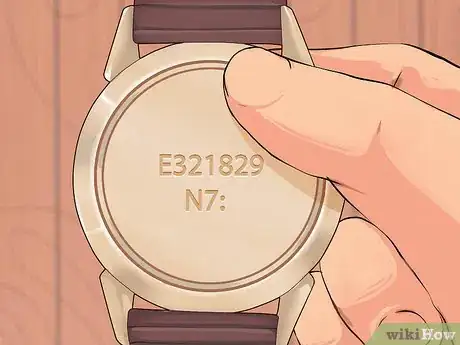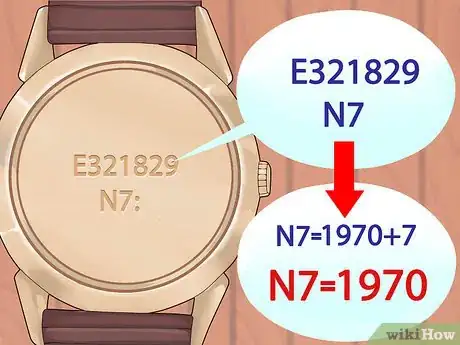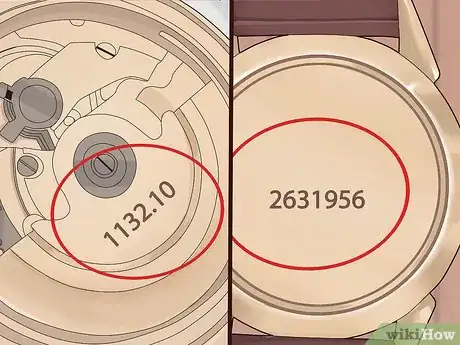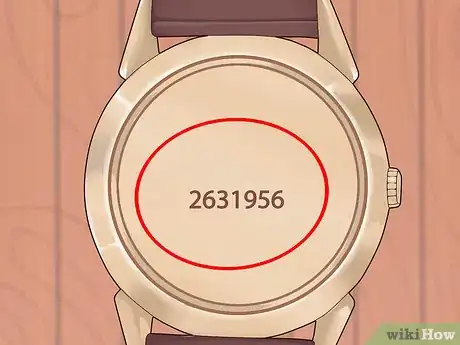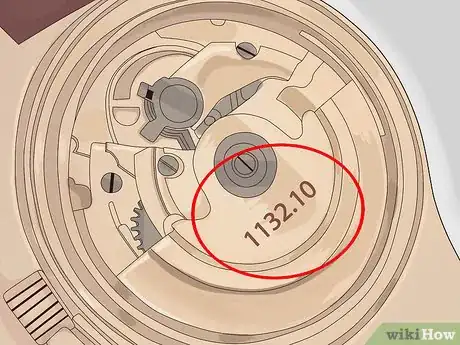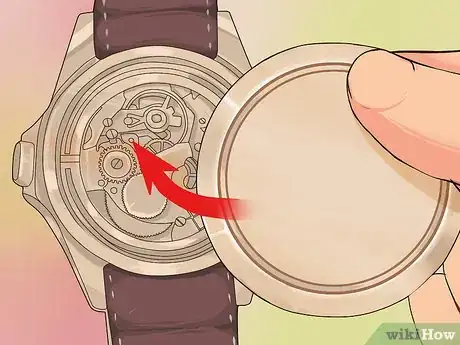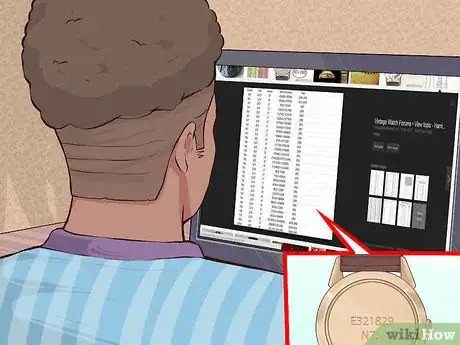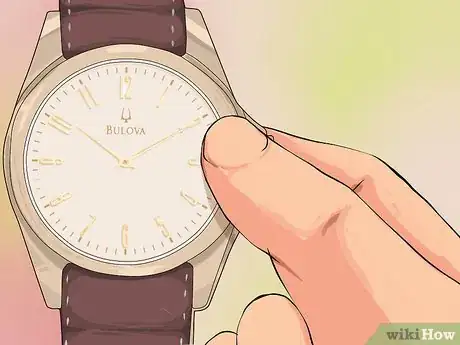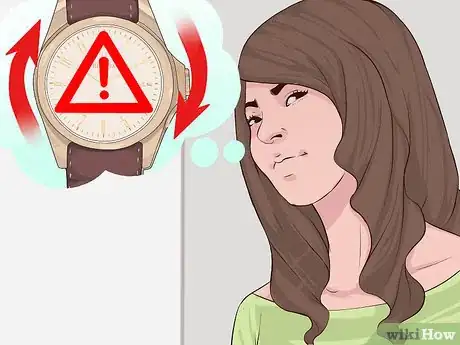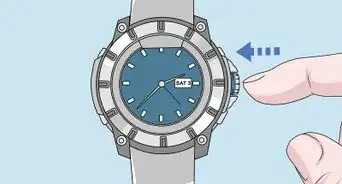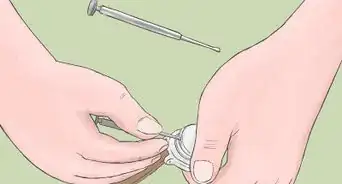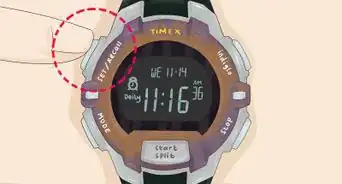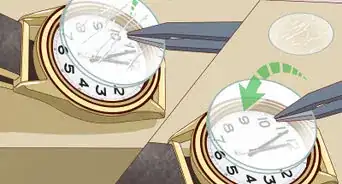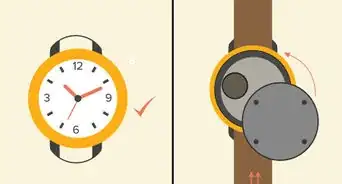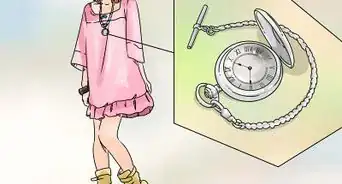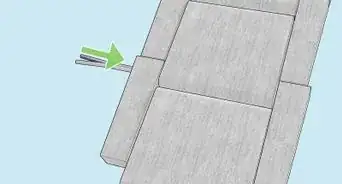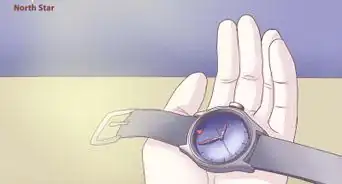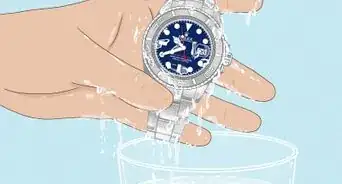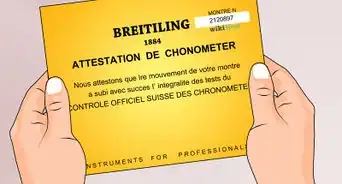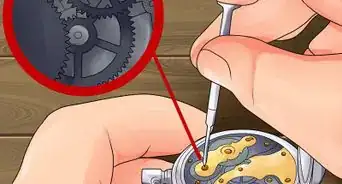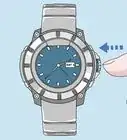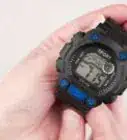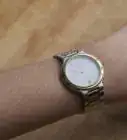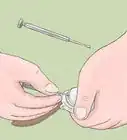This article was co-authored by wikiHow Staff. Our trained team of editors and researchers validate articles for accuracy and comprehensiveness. wikiHow's Content Management Team carefully monitors the work from our editorial staff to ensure that each article is backed by trusted research and meets our high quality standards.
This article has been viewed 243,726 times.
Learn more...
Finding out what model your Bulova watch is can be quite challenging. This is because there are no model numbers stamped on them. There are often date codes and/or serial numbers, however, which can help you determine how old the watch is. Using this information, you can compare your watch to the models that were made during that time period to identify the model.
Steps
Determining the Age of the Watch by Looking for Date Codes
-
1Look for a date code stamped on the back of the case. Take your watch off and flip it over to look at the smooth metal back of the case. You may see several different markings engraved there, all of which have different meanings. A date code will be either a symbol (like a triangle, and eight-pointed star, or a half-moon, for example), a two-digit number, or one letter and one number. [1]
- You may need to use a magnifying glass to help you read the codes, as they are very small.
- If your watch was produced earlier than 1924, it will not have any date code on it.
- You may also see a serial number on the back of your watch. This can also be useful in helping you identify how old your watch is, but it is not the model number.
-
2Interpret the date code. Once you have identified a date code on your watch, you will need to interpret it, as the date is never printed in an obvious way. Bulova has used a few different systems for dating their watches.[2]
- Between 1924 and 1945, a series of symbols was used to indicate the year in which the watch was produced. If you see a symbol, do an internet search to find a table that will show year which year corresponds to which symbol. Be aware, however, that some symbols were used more than once. For example, a circle was used in 1925, 1934, and 1944.
- A transitional system was used between 1946 and 1949. In 1946, the code was 46 followed by a square. In 1947, the code was 47. In 1948, the code was 48. In 1949, the code was J9.
- Beginning in 1950, Bulova started using a code including one letter and one number. The letter indicates the decade, while the number indicates the year within the decade. The decade codes are as follows: L = 1950s, M = 1960s, N = 1970s, P = 1980s, T = 1990s. For example, if your watch is stamped with the code M8, this means your watch was produced in 1968. If it is stamped with the cope P0, your watch was produced in 1980.
Advertisement -
3Understand the meaning of patent dates. As you are looking for identifying markings on your watch, you may come across a patent date. Patent dates typically include a month, day, and year, and are preceded by the letters "pat." Some people jump to the conclusion that this is the date that their watch was manufactured, but it is not. The patent date is merely the date on which the specific design of the watch was patented, so it will not be of much use.[3]
- Patent dates may be helpful in helping you rule out certain dates of manufacture. For example, if your watch's design was patented in 1950, you know your watch could not have been produced any earlier than 1950 (but it could have been produced any time after 1950).
Determining the Age of the Watch by Looking for Serial Numbers
-
1Be aware of the two types of serial numbers. On many watches, you will find two different serial numbers: one on the case of the watch, and one on the interior mechanism of the watch. This is because the two are often manufactured separately.[4]
- If you check both the case and the mechanism and discover that they were made in different years, this can be due to several reasons. If the difference is only one year, it may simply be that one component was manufactured first and then warehoused until it was needed to assemble the watch. If the difference is more than a year, it is likely that one of the elements has been replaced.
-
2Find the serial number on the case. To find the serial number on the case of your Bulova watch, simply flip it over and look at the flat back of the case. If there is a serial number, it should be engraved here.[5]
- Serial numbers do not all contain the same number of digits.
- Not all Bulova watches will have serial numbers on the case. If yours does not, you may want to consider looking for a serial number on the mechanism.
- You may want to use a magnifying glass to help you read the serial number.
- If you already looked for a date code on your watch, you may have already found the serial number.
-
3Find the serial number on the interior mechanism. If there are no identifying marks on the outside of your watch, or if you want to know the model number of the movement that was used in your watch, you will have to take the back case off. The serial number may be located anywhere on the mechanism. Be very careful doing this, as you can damage the watch if you are careless.[6]
- Be sure to place the watch on a soft cloth as you are working in order to prevent it from getting damaged.
- If the watch has a snap back case, you should be able to see a raised lip around the back and bezel of the case. There won't be any hinges or notches. Snap back cases simply snap into place, so you should be able to remove one by prying it up with a dull tool. Don't use anything sharp (like a knife blade) that you might cut yourself with.
- Some older watches have swing-back cases, which can be identified by a hinge on the back of the case. These are opened the same way as snap back cases, but the back hinges open instead of coming all the way off. You may even be able to open this type of back with your fingernail.
- If the watch has a screw back case, you should see six grooves or notches located somewhere along the perimeter of the metal back. You will need to open the back case using these notches. Screw back cases must be unscrewed before you can lift them away. You will need a special tool known as an adjustable case wrench to open one.
- There may also be a second protective cover inside of your watch. This can usually be pried off with a fingernail, but be careful not to damage the mechanism as you are doing this.
- If you have any trouble getting the case open, bring the watch to a professional jeweler.
-
4Replace the back case. If you opened the back of your watch to locate a serial number, be sure to put it back together right away.
- For snap back watches, locate the small pin on the inner lip of the case and the small hole around the perimeter of the watch. Line up the pin and the hole, then press and click the case back on using your hands.
- For screw back cases, place the case over the back of the watch and grab onto the grooves using the case wrench. Rotate the case clockwise until it screws back into place.
-
5Compare the serial number to online lists. Once you have identified a serial number on your watch, you can try searching for the number online or using an online chart to help you identify when the watch was made. There is no official Bulova chart to reference, but many people have compiled charts based on their own observations of patterns.
- Some serial numbers are easier to identify than others. For example, watches that were produced before 1926 tend to have serial numbers that start with the numbers 1 or 2, but the exact number does not give any further clues as to its production date.[7]
- Between 1926 and 1949, the first digit of the serial number was typically used to indicate in which year within a decade the watch was produced. For example, a serial number that starts with 1 could indicate that that watch was produced in 1931 or 1941.
Comparing Your Watch to Known Models
-
1Find a list of models. Once you have identified the age of your watch, you can begin comparing it to the models that Bulova produced during those years. Luckily, there are lots of websites that include complete lists of Bulova models (with pictures) organized by year. Scroll through one of these lists until you find a model that matches your watch.[8]
- Be aware that there are often some variations within models. For example, Bulova may have offered the same model with different choices for case material, movement, dial, and hands.
-
2Note the shape of the case. When comparing your watch to various models, pay the most attention to the shape of the watch's case. Even if there were different options offered for the model, the general shape and lines should be the same.
- After the shape, pay attention to the dial features, as these are also likely to remain the same, even if different options were offered. Note details like the placement of the hands and the sub-seconds.
-
3Be aware of repeated model names. If you find a model that matches your watch, you should be aware that Bulova did sometimes reuse model names. For this reason, the model name alone (without the year) may not be very useful in identifying a watch.
Community Q&A
-
QuestionWhat model is my Bulova Automatic with number F320470 on the bottom back and M7 below that number?
 Community AnswerAccording to the above wikihow article, L=50's, M=60's, etc. Seven refers to the year within the decade. This means your Bulova is dated 1967. Look up Bulovas produced in that year, and you should find that model.
Community AnswerAccording to the above wikihow article, L=50's, M=60's, etc. Seven refers to the year within the decade. This means your Bulova is dated 1967. Look up Bulovas produced in that year, and you should find that model. -
QuestionMy watch has no identifying numbers on the back, and I cannot get it open to find the serial number. How do I find the model number otherwise?
 Community AnswerTake your watch to a jewelry store. The jeweler should be able to open the watch without damaging it to retrieve the model number.
Community AnswerTake your watch to a jewelry store. The jeweler should be able to open the watch without damaging it to retrieve the model number. -
QuestionI bought a used watch. Where can I find information on it?
 Community AnswerA simple internet search would be best. If you want a little bit more information, try emailing or calling the watch manufacturer or the person who owned the watch first.
Community AnswerA simple internet search would be best. If you want a little bit more information, try emailing or calling the watch manufacturer or the person who owned the watch first.
Warnings
- Work carefully when opening the back of a Bulova watch. If you handle it too recklessly, you may damage the inner gears or get debris inside the watch. Small pieces may also fall out if you drop the watch.⧼thumbs_response⧽
References
- ↑ http://www.pocketwatchrepair.com/histories/bulova.php
- ↑ http://www.pocketwatchrepair.com/histories/bulova.php
- ↑ http://www.watchophilia.com/general-information/determining-the-date-of-a-watch/
- ↑ http://www.watchophilia.com/general-information/determining-the-date-of-a-watch/
- ↑ http://www.watchophilia.com/general-information/determining-the-date-of-a-watch/
- ↑ http://www.thewatchguy.com/pages/OPENCASE.html
- ↑ http://www.watchophilia.com/general-information/determining-the-date-of-a-watch/
- ↑ http://www.watchophilia.com/photogallery/
- ↑ http://www.watchophilia.com/general-information/determining-the-date-of-a-watch/
About This Article
Since Bulova watches don't have model numbers, you'll need to use the serial number and date code to determine what model your watch is. Take your watch off and flip it over to look at the smooth metal back of the case. Here, you should see a date code, which will either be a symbol, like a triangle or a half-moon, two-digit number, or a letter and number. Once you find the date code, look it up on the internet to figure out when it was made. Another way to date your watch is by comparing the serial number to an online list. To find the serial number, look at the back of the case. If you can't find a serial number here, you'll have to carefully remove the backing of your watch to look at the mechanism. After you locate the serial number, search for it on the internet to find the year it was made. Then, look up models made that same year until you find your Bulova. To learn how to find a list of models online, keep reading!
